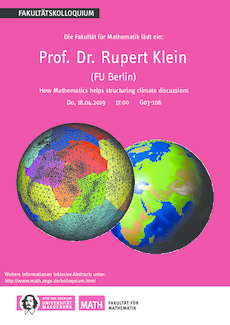Prof. Dr. Rupert Klein
Mathematics in climate research is often thought to be mainly a provider of techniques for solving the continuum mechanical equations for the flows of the atmosphere and oceans, for the motion and evolution of Earth’s ice masses, and the like. Three examples will elucidate that there is a much wider range of opportunities. Climate modellers often employ reduced forms of “the continuum mechanical equations” to efficiently address their research questions of interest. The first example discusses how mathematical analysis can provide systematic guidelines for the regime of applicability of such reduced model equations. Meteorologists define “climate”, in a narrow sense, as “the statistical description in terms of the mean and variability of relevant quantities over a period of time” (World Meteorological Society, http://www.wmo.int; see the website for a broader sense definition). Now, climate researchers are most interested in changes of the climate over time, and yet there is no unique, well-defined notion of “time dependent statistics”. In fact, there are restrictive conditions which data from time series need to satisfy for classical statistical methods to be applicable. The second example describes recent developments of analysis techniques for time series with non-trivial temporal trends. Modern climate research has joined forces with economy and the social sciences to generate a scientific basis for informed political decisions in the face of global climate change. One major type of problems hampering progress of the related interdisciplinary research consists of often subtle language notion of “vulnerability” has helped structuring related interdisciplinary research efforts.
Datum: 18.04.2019, Raum: G03-106, Zeit: 17:00





